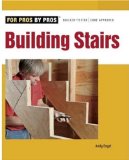 In today’s post, I’m going to talk about building stairs. Before we can build stairs, there are a few terms that you must know and understand. We’ll talk about those terms first and then get into the design and construction of stairs.
In today’s post, I’m going to talk about building stairs. Before we can build stairs, there are a few terms that you must know and understand. We’ll talk about those terms first and then get into the design and construction of stairs.
-
Stair Treads-The portion of the stairs that you step on when you go up or down the stairs.
-
Risers-This is the vertical spacing between each of the stair treads. The risers can be either open or closed, but in this discussion, I’ll only be talking about open risers.
-
Stair Stringers-These are the support pieces that the stair treads are attached to and are set at an angle under the stair treads.
-
Run-This is the distance measured horizontally from the top of the stairs to the bottom of the stairs.
-
Rise-Not to be confused with the risers, the rise is the distance measured vertically from the top of the stairs to the bottom.
-
Landing-This is the horizontal surface at the top and bottom of the stairs. In outdoor stairs, the top landing is typically called a deck and the bottom landing is usually the ground.
-
Handrail-This is the part of the stairs on one or both sides of the stairs that keep you from falling from the stairs.
-
Balusters-These are the decorative vertical pieces that support the handrail.
Now that we’ve gotten the terminology out of the way, we can get down to the business of designing our stairs. Before we can design the stairs, we have to take some measurements. In this discussion, I’m going to teach you how to cut your own stringers instead of using pre-cut stringers from the lumber store. Pre-cut stringers are Ok if you have a standard height deck or porch, but they don’t work well otherwise.
In order to keep this post from running so long and throwing too much information at you at one time, I’m going to break it up into a series of small posts. If you want more information about building stairs, I recommend this book entitled Building Stairs. There are plenty of illustrations to help you build the most complicated stairs.
So until next time, stay safe, work hard, and as always, thanks for stopping by MVB Crafts.
Regards,

P.S.
If this article has helped you but you would like more information, click here and buy the book. By clicking the link, I’ll get a commission on the sale and you’ll get some great information.

